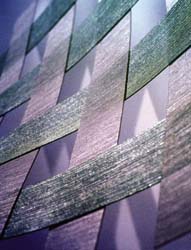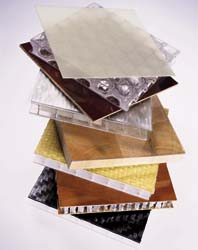There was a time when retail stores were crawling with visual merchandising personnel, who, like worker ants, doggedly rearranged heavy, complex fixturing for seasonal makeovers. That time has passed; money is tight, space is at a premium and staffing more closely resembles a depleted ant farm. Retailers today seek versatility in surface materials: They want lightweight, multi-functional, durable products, while retaining creative design and aesthetics.
Christine Belich, executive creative director of Sony Plaza (New York), foresees innovations in surface material design due to advances in digital technology. “In this world of materials,” Belich says, “technology is one of the only truly 'new'things we have.” As the cost of industry technology decreases, she predicts that precision printing on materials will put more control in the designers'hands.
Milliken Carpet (LaGrange, Ga.) capitalized on this idea of control and creative flexibility when it collaborated with Gensler (San Francisco) to design Oxygen™, a new collection of modular carpet tiles. Because improved printing technology allows the tiles to be dyed individually, retailers can better mix and match Oxygen's eight design groups and 15 patterns to compose their own graphic art on the floor. According to Bill Erwin, Milliken's corporate design manager, retailers derive several advantages from Gensler's “building-block” approach: easy directionals for shoppers; mixed floor patterning directly relating to the store's fixturing or lighting plans; and photo-realistic imaging, including trendy shapes and colors. “This technology creates a stimulating environment that reflects the fashion world, which is what retailers have been asking for,” Erwin says.
Similarly, designers at Checkland Kindleysides (Leicester, England) customized Amtico's (Atlanta) Colormetrics magnetically embossed vinyl tile to clarify product zoning and store navigation at Speedo's London flagship.
Looking at versatile design from a mobility standpoint, David Ashen of d/g* Worldwide (New York) is perusing lightweight, easily maneuvered materials for the Dallas and Houston locations of Stephanie Anne, a Dallas-based furniture retailer. For back paneling, fixturing and wall dividers, Ashen is considering carbon fiber surfaces from Airframe™ (New York), which specializes in blended materials from aerospace and marina engineering. According to Zenda Snyder, an Airframe partner, the panels are shatter-proof, can be treated with ultraviolet protection for outdoor applications, and are available with translucent or opaque qualities.
Advertisement
While scouting for his own projects, Ashen notes that other architects are looking for sculptural flexibility from sturdy materials. Sheet materials like Aero, from Forms Surfaces (Carpinteria, Calif.), evolved from this demand. Consisting of tightly corrugated anodized aluminum, this lightweight material can be rolled as a decorative panel across the ceiling, down the wall and then shaped into seating.
Carnegie, a Rockville Centre, N.Y., textile manufacturer, takes utility to the next level with Xorel® Surfaces, a hard material that is intended to suit virtually any surface application. Company president Cliff Goldman describes the product as polyester resin with the colors, patterns and texture of woven fabrics. Depending on the design project, the product can be drilled, cut, bent, backlit or embossed. “The material as a wall panel is a very up-and-coming idea, because dividers can be moved around so easily,” Goldman says.
Jeff Mason, visual merchandising director of The Paradies Shops (Atlanta), articulates retail's ongoing search: “If it's durable and attractive, I want to hear more about it,” he says. “I was inspired the other day by wood that had been soaked, shaped and re-hardened so that it twisted beautifully. That's what you're seeing with surfaces today – a generic material can become something new, part of the beauty of a store.”


 Headlines1 week ago
Headlines1 week ago
 Headlines1 week ago
Headlines1 week ago
 Headlines1 week ago
Headlines1 week ago
 Designer Dozen2 weeks ago
Designer Dozen2 weeks ago
 Headlines6 days ago
Headlines6 days ago
 Headlines3 days ago
Headlines3 days ago
 Designer Dozen7 days ago
Designer Dozen7 days ago
















